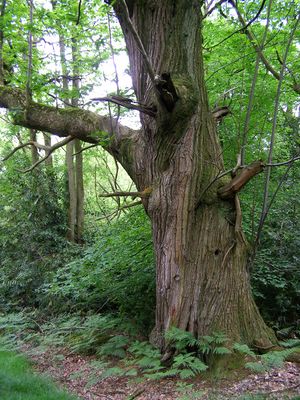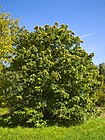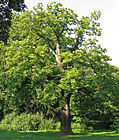Note: This is a project under development. The articles on this wiki are just being initiated and broadly incomplete. You can Help creating new pages.
Difference between revisions of "Castanea sativa - Sweet chestnut"
(→Photo Gallery) |
(→Identification) |
||
| (10 intermediate revisions by 2 users not shown) | |||
| Line 1: | Line 1: | ||
[[File:Large sweet chestnut tree in the Quar Hill Plantation - geograph.org.uk - 176307.jpg|thumb|right|''Marron'', Sweet chestnut]] | [[File:Large sweet chestnut tree in the Quar Hill Plantation - geograph.org.uk - 176307.jpg|thumb|right|''Marron'', Sweet chestnut]] | ||
'''Castanea sativa''' is a species of Flowering plant in the family '''Fagaceae'''. It is native to Europe and Asia Minor. It is widely cultivated throughout the temperate world. | '''Castanea sativa''' is a species of Flowering plant in the family '''Fagaceae'''. It is native to Europe and Asia Minor. It is widely cultivated throughout the temperate world. | ||
| − | |||
==Uses== | ==Uses== | ||
{{Uses|Bleeding}}, {{Uses|Fever}}, {{Uses|Ague}}, {{Uses|Cough}}, {{Uses|Rheumatism}}, {{Uses|Joint pain}}, {{Uses|Diarrhea}}, {{Uses|Sore throats}} | {{Uses|Bleeding}}, {{Uses|Fever}}, {{Uses|Ague}}, {{Uses|Cough}}, {{Uses|Rheumatism}}, {{Uses|Joint pain}}, {{Uses|Diarrhea}}, {{Uses|Sore throats}} | ||
| Line 9: | Line 8: | ||
==Chemical Composition== | ==Chemical Composition== | ||
| − | They contained (g/100g dry matter basis) total carbohydrates | + | They contained (g/100g dry matter basis) total carbohydrates.<ref name="chemical composition"/> |
==Common names== | ==Common names== | ||
| Line 35: | Line 34: | ||
==Identification== | ==Identification== | ||
===Leaf=== | ===Leaf=== | ||
| − | {{Leaf|Simple|| | + | {{Leaf|Simple||There is one leaf per node along the stem and the edge of the leaf blade has teeth}}<ref name="Leaf"/> |
===Flower=== | ===Flower=== | ||
| − | {{Flower|Bisexual|2-4cm long| | + | {{Flower|Bisexual|2-4cm long|Brown|5|These catkins are 10 to 20 cm long and appear in late June to July}} |
===Fruit=== | ===Fruit=== | ||
| − | {{Fruit| | + | {{Fruit|General||The fruit is dry but does not split open when ripe|The bark of an adult plant is ridged or plated|}} |
===Other features=== | ===Other features=== | ||
==List of Ayurvedic medicine in which the herb is used== | ==List of Ayurvedic medicine in which the herb is used== | ||
| − | |||
==Where to get the saplings== | ==Where to get the saplings== | ||
| Line 53: | Line 51: | ||
==How to plant/cultivate== | ==How to plant/cultivate== | ||
| − | + | Seed - where possible sow the seed as soon as it is ripe in a cold frame or in a seed bed outdoors. The seed must be protected from mice and squirrels.<ref name="How to plant/cultivate"/> | |
==Commonly seen growing in areas== | ==Commonly seen growing in areas== | ||
| Line 67: | Line 65: | ||
File:Sweet Chestnut Forest.jpg|A tree in the Swiss alps | File:Sweet Chestnut Forest.jpg|A tree in the Swiss alps | ||
File:Edelkastanie (Castanea sativa) 1.jpg|tree | File:Edelkastanie (Castanea sativa) 1.jpg|tree | ||
| + | File:Castanea sativa foliage Artvin.jpg|Leaves | ||
| + | File:Blüte Edelkastanie.jpg|Male Inflorescence | ||
| + | File:Castanea sativa 0004.JPG|Female inflorescence | ||
| + | File:Edelkastanien.jpg|Fruits | ||
| + | File:Castanea sativa - Infructescence, Fruchtstand.JPG|Fruits | ||
| + | File:Chestnut02.jpg|Chestnuts | ||
| + | File:2006-11-16Castanea sativa01.jpg|Seeds | ||
| + | |||
</gallery> | </gallery> | ||
| Line 72: | Line 78: | ||
<references> | <references> | ||
| − | <ref name="chemical composition">[http://www.scielo.br/scielo.php?script=sci_arttext&pid=S1516-89132006000300001 | + | <ref name="chemical composition">[http://www.scielo.br/scielo.php?script=sci_arttext&pid=S1516-89132006000300001 Chemical composition of Castanea sativa ]</ref> |
| − | <ref name="Leaf">[https://gobotany.newenglandwild.org/species/castanea/sativa/ | + | <ref name="Leaf">[https://gobotany.newenglandwild.org/species/castanea/sativa/ Charecteristics]</ref> |
| − | <ref name="How to plant/cultivate">[https:// | + | <ref name="How to plant/cultivate">[https://pfaf.org/user/plant.aspx?LatinName=Castanea+sativa Cultivation details]</ref> |
</references> | </references> | ||
| Line 85: | Line 91: | ||
[[Category:Herbs]] | [[Category:Herbs]] | ||
| − | [[Category: | + | [[Category:Fagaceae]] |
| − | |||
Latest revision as of 17:13, 10 April 2020
Castanea sativa is a species of Flowering plant in the family Fagaceae. It is native to Europe and Asia Minor. It is widely cultivated throughout the temperate world.
Contents
- 1 Uses
- 2 Parts Used
- 3 Chemical Composition
- 4 Common names
- 5 Properties
- 6 Habit
- 7 Identification
- 8 List of Ayurvedic medicine in which the herb is used
- 9 Where to get the saplings
- 10 Mode of Propagation
- 11 How to plant/cultivate
- 12 Commonly seen growing in areas
- 13 Photo Gallery
- 14 References
- 15 External Links
Uses
Bleeding, Fever, Ague, Cough, Rheumatism, Joint pain, Diarrhea, Sore throats
Parts Used
Chemical Composition
They contained (g/100g dry matter basis) total carbohydrates.[1]
Common names
| Language | Common name |
|---|---|
| Kannada | |
| Hindi | |
| Malayalam | |
| Tamil | |
| Telugu | |
| Marathi | NA |
| Gujarathi | NA |
| Punjabi | NA |
| Kashmiri | NA |
| Sanskrit | |
| English | Sweet chestnu |
Properties
Reference: Dravya - Substance, Rasa - Taste, Guna - Qualities, Veerya - Potency, Vipaka - Post-digesion effect, Karma - Pharmacological activity, Prabhava - Therepeutics.
Dravya
Rasa
Guna
Veerya
Vipaka
Karma
Prabhava
Habit
Identification
Leaf
| Kind | Shape | Feature |
|---|---|---|
| Simple | There is one leaf per node along the stem and the edge of the leaf blade has teeth |
Flower
| Type | Size | Color and composition | Stamen | More information |
|---|---|---|---|---|
| Bisexual | 2-4cm long | Brown | 5 | These catkins are 10 to 20 cm long and appear in late June to July |
Fruit
| Type | Size | Mass | Appearance | Seeds | More information |
|---|---|---|---|---|---|
| General | The fruit is dry but does not split open when ripe | The bark of an adult plant is ridged or plated | {{{6}}} |
Other features
List of Ayurvedic medicine in which the herb is used
Where to get the saplings
Mode of Propagation
How to plant/cultivate
Seed - where possible sow the seed as soon as it is ripe in a cold frame or in a seed bed outdoors. The seed must be protected from mice and squirrels.[3]
Commonly seen growing in areas
Mountain area, Temperate region.
Photo Gallery
A tree in Marchin, Belgium
References
External Links
- Ayurvedic Herbs known to be helpful to treat Bleeding
- Ayurvedic Herbs known to be helpful to treat Fever
- Ayurvedic Herbs known to be helpful to treat Ague
- Ayurvedic Herbs known to be helpful to treat Cough
- Ayurvedic Herbs known to be helpful to treat Rheumatism
- Ayurvedic Herbs known to be helpful to treat Joint pain
- Ayurvedic Herbs known to be helpful to treat Diarrhea
- Ayurvedic Herbs known to be helpful to treat Sore throats
- Herbs with Seeds used in medicine
- Herbs with Bark used in medicine
- Herbs with common name in English
- Habit - Tree
- Index of Plants which can be propagated by Seeds
- Index of Plants which can be propagated by Cuttings
- Herbs that are commonly seen in the region of Mountain area
- Herbs that are commonly seen in the region of Temperate region
- Herbs
- Fagaceae














